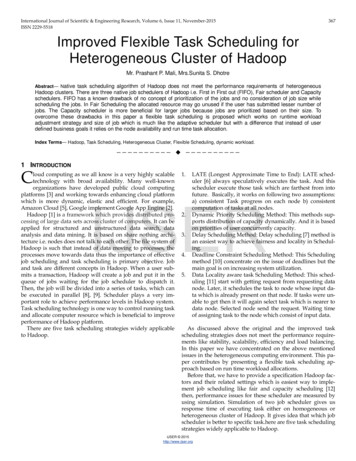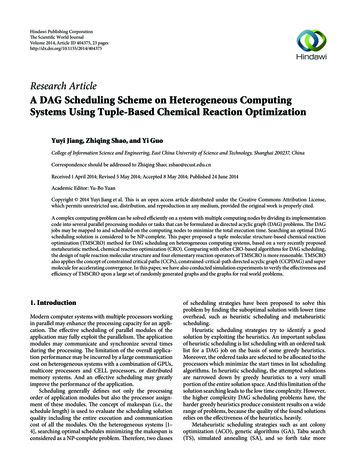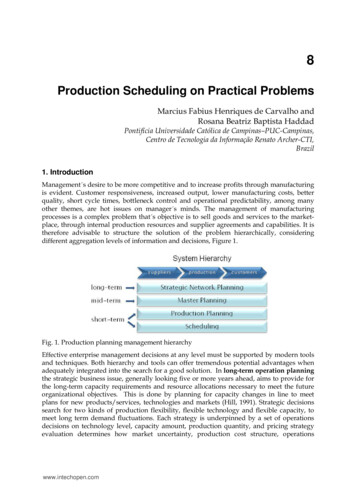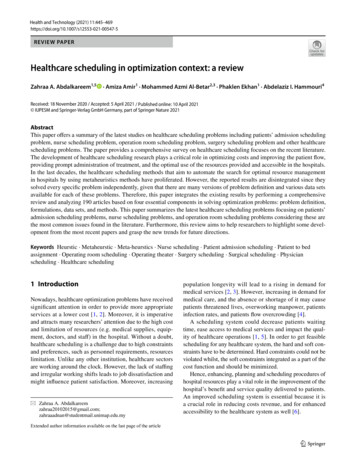
Transcription
International Journal of Scientific & Engineering Research, Volume 6, Issue 11, November-2015ISSN 2229-5518367Improved Flexible Task Scheduling forHeterogeneous Cluster of HadoopMr. Prashant P. Mali, Mrs.Sunita S. DhotreAbstract— Native task scheduling algorithm of Hadoop does not meet the performance requirements of heterogeneousHadoop clusters. There are three native job schedulers of Hadoop i.e. First in First out (FIFO), Fair scheduler and Capacityschedulers. FIFO has a known drawback of no concept of prioritization of the jobs and no consideration of job size whilescheduling the jobs. In Fair Scheduling the allocated resource may go unused if the user has submitted lesser number ofjobs. The Capacity scheduler is more beneficial for larger jobs because jobs are prioritized based on their size. Toovercome these drawbacks in this paper a flexible task scheduling is proposed which works on runtime workloadadjustment strategy and size of job which is much like the adaptive scheduler but with a difference that instead of userdefined business goals it relies on the node availability and run time task allocation.Index Terms— Hadoop, Task Scheduling, Heterogeneous Cluster, Flexible Scheduling, dynamic workload.—————————— ——————————1 INTRODUCTIONCloud computing as we all know is a very highly scalabletechnology with broad availability. Many well-knownorganizations have developed public cloud computingplatforms [3] and working towards enhancing cloud platformwhich is more dynamic, elastic and efficient. For example,Amazon Cloud [5], Google implement Google App Engine [2].Hadoop [1] is a framework which provides distributed processing of large data sets across cluster of computers. It can beapplied for structured and unstructured data search, dataanalysis and data mining. It is based on share nothing architecture i.e. nodes does not talk to each other. The file system ofHadoop is such that instead of data moving to processes, theprocesses move towards data thus the importance of effectivejob scheduling and task scheduling is primary objective. Joband task are different concepts in Hadoop. When a user submits a transaction, Hadoop will create a job and put it in thequeue of jobs waiting for the job scheduler to dispatch it.Then, the job will be divided into a series of tasks, which canbe executed in parallel [8], [9]. Scheduler plays a very important role to achieve performance levels in Hadoop system.Task scheduling technology is one way to control running taskand allocate computer resource which is beneficial to improveperformance of Hadoop platform.There are five task scheduling strategies widely applicableto Hadoop.1.LATE (Longest Approximate Time to End): LATE scheduler [6] always speculatively executes the task. And thisscheduler execute those task which are farthest from intofuture. Basically, it works on following two assumptions:a) consistent Task progress on each node b) consistentcomputation of tasks at all nodes.Dynamic Priority Scheduling Method: This methods supports distribution of capacity dynamically. And it is basedon priorities of user concurrently capacity.Delay Scheduling Method: Delay scheduling [7] method isan easiest way to achieve fairness and locality in Scheduling.Deadline Constraint Scheduling Method: This Schedulingmethod [10] concentrate on the issue of deadlines but themain goal is on increasing system utilization.Data Locality aware task Scheduling Method: This scheduling [11] start with getting request from requesting datanode. Later, it schedules the task to node whose input data which is already present on that node. If tasks were unable to get then it will again select task which is nearer todata node. Selected node send the request. Waiting timeof assigning task to the node which consist of input data.IJSER2.3.4.5.As discussed above the original and the improved taskscheduling strategies does not meet the performance requirements like stability, scalability, efficiency and load balancing.In this paper we have concentrated on the above mentionedissues in the heterogeneous computing environment. This paper contributes by presenting a flexible task scheduling approach based on run time workload allocations.Before that, we have to provide a specification Hadoop factors and their related settings which is easiest way to implement job scheduling like fair and capacity scheduling [12]then, performance issues for these scheduler are measured byusing simulation. Simulation of two job scheduler gives usresponse time of executing task either on homogeneous orheterogeneous cluster of Hadoop. It gives idea that which jobscheduler is better to specific task.here are five task schedulingstrategies widely applicable to Hadoop.IJSER 2015http://www.ijser.org
International Journal of Scientific & Engineering Research, Volume 6, Issue 11, November-2015ISSN pp368B. Task obtaining and scheduling process of Hadoop:To process multiple task at the same time, Hadoop bydefault use following task scheduling strategy.1) Tasktrackers count running tasks.2) It determines whether running task is less than fix task capacity or not.3) Using flag, It determines whether node is available to obtainnew task or not.Remote Procedure Call (RPC) method is used by default by tasktracker that periodically sends heartbeat to jobtracker. When jobtracker get tasks, it will splits up those tasksand send them to tasktracker to execute.HDFSJobTrackerTaskTrackerC. Problem AnalysisIn heterogeneous environment every nodes load changes dynamically which means different node performs differentlywhich may lead to below discussed performance issues:OutputFigure 1. Hadoop Workflow1)2 RELATED WORKWhen the node is high performance computing node andthe existing number of running tasks is equal to the allocated fixed slots, the task tracker is not expected to acquirenew tasks. But if the node is still underutilized then whichis a hunger situation and can run more tasks will lead towaste of resourceWhen the node is a low performance computing node andthe number of tasks running is less than the allocatedfixed slots then the node can acquire new task but if thenode is heavily loaded and cannot host new task which isa saturation situation will lead to overloadIJSERSome of task scheduling strategies that have been proposed inrecent years:In 2009, M. Yong et al. [6] introduced task-tracker resourceaware scheduler (TRAS). In this algorithm, each task-trackercollects its own resource information and then reports thesame to the job-tracker for the next resource scheduling.Reference [9] proposed a speculative task execution strategy(STES) in 2005. Even If the cluster has already finished most ofthe tasks, few of the tasks may be left due to insufficienthardware performance and become trailing task. In order toreduce the influence of trailing tasks on the whole job execution time, job-tracker will restart copies of trailing tasks running in parallel; once any one of the task is executed, thewhole job is completed.In 2013, Z. Tang et al. [16] showed Map reduce task scheduling algorithm for deadline constraint (MTSD), which allowsuser to specify a jobs deadline and makes it finished before thedeadline.A. System Architecture of Hadoop:Hadoop is made up of two core parts: Hadoop Distributed File System (HDFS) and MapReduce [13]. HDFS provides redundant storage of massive amount of data. It provides reliability through replication. It stores files as block.HDFS operates on two types of nodes: Namenode (Master)which stores all metadata and Datanode that stores Files contents in blocks. MapReduce is programming platform for distributing a task across multiple nodes. It is composed of twotypes of nodes: Jobtracker and Tasktracker. Jobtracker coordinates all jobs using default scheduling strategy of Hadoop.Tasktrackers processes tasks and send reports back to Jobtracker.2)Thus an ideal task scheduling and tracking mechanism whichdynamically adjusts to the load at run time and the node capability to run tasks and acquire tasks accordingly will improve the clusters performance.3 FLEXIBLE TASK SCHEDULING ALGORITHMWhole research is divided into two parts. In first part, wehave worked on simulation of fair scheduler and capacityscheduler on single cluster and try to find out which scheduleris better to work on which type of task.In second part, Our main focus to introduce a novel approach of task scheduling for heterogeneous Hadoop, wherein a running cluster the task tracker on its own will make theadjustments to achieve the most optimal state based onruntime load adjustment for the resource availableThe high level steps can be defined as below:1.Task Tracker periodically weighs its load, which is termed asheartbeat interval based on predefined load parameters.2. Dynamic allocation of max allocated slots for the tasks. Thisis a deviation from the Hadoop classical approach of oneheartbeat and full allocation.IJSER 2015http://www.ijser.org
International Journal of Scientific & Engineering Research, Volume 6, Issue 11, November-2015ISSN 2229-5518Output: AskForNewTask, MaxTasksCapacityTask SchedulerXMLRPCXMLRPCXMLRPCFTSAFTSATask ExecutingModuleTask ExecutingModule1 for (i 0; i 3; i ) {/ In a heartbeat interval, collect three sets of loadInformation, deposit them in a corresponding loadarray /2 CpuQueue[i] ResourceMonitor.getCpuInfo ();/ Get CPU utilization by calling getCpuInfo () /3 AvgTQ [i] ResourceMonitor.getLoadAverage ();4 MemQueue[i] ResourceMonitor.getMemInfo ();/ Get MEM utilization by calling getMemInfo () /5 Thread.sleep (WaitTime);/ Wait forWaitTime, in order to reach informationAcquisition cycle /6}7 for (j 0; j 3; j ) {8 countCpu CpuQueue[j];9 countLoad AvgTQ [j];10 countMem MemQueue[j];11}12 CpuUsage countCpu/3;/ CPU utilization in this heartbeat interval /13 AvgTQ countLoad/3;/ The average length of single core task queue in thisHeart beat interval /14 MemUsage countMem/3;/ MEM utilization in this heartbeat interval /15 if (CpuUsage Cthre&&AvgTQ Lthre&&MemUsage Mthre) {/ Load judgment, get the value of StatusCount /16 StatusCount StatusCount 1;17}18 HeartBeatCount HeartBeatCount 1;19 AskForNewTask RunningTasks MaxTasksCapacity;/ Set the flag of obtaining new task(AskForNewTask) /20 if (HeartBeatCount X) {/ After reaching X heartbeat intervals, make correspondingdecision /21 if (MaxTasksCapacity Max) {22 MaxTasksCapacity MaxTasksCapacity 1;23 StatusCount 0;24 HeartBeatCount 0;25}26 if (MaxTasksCapacity Min) {27 MaxTasksCapacity MaxTasksCapacity 1;28 StatusCount 0;29 HeartBeatCount 0;30}31}IJSERFigure 2. Environment of FTSA4 ALGORITHM DESCRIPTIONThe load parameters considered here are CPU Usage (CUsage), Memory Usage (MUsage) and Average Length Of TaskQueue(AvgTQ) these information can be calculated based onthe user-mode time (user), low-priority user-mode time(prior),system-mode time (sys), idle task-mode time (idle), hard diskI/O preparing time (ioprep), hardware interrupting time(ihrq),and software interrupting time (isrq) from the File System ofOS[15].CUsage (user prior sys)/ total 100(I)total (user prior sys idle ioprep ihrq isrq)(II)AvgTQ is a parameters from file /proc/loadavg which reflectthe average task queue length of a single core. The numeratoris the execution time of non-system idle process and denominator is the total execution time of CPU.MemUsage (MemTotal MemFree Buffers Cache)/MemTotal (III)The following is the pseudo code of our algorithmInput: Current tasktracker load informationMax, Min: the maximum and minimum number ofCPU cores of the heterogeneous cluster nodesInitial value of MaxTasksCapacityX: heartbeat intervalsCthre, Lthre: threshold parameterIJSER 2015http://www.ijser.org369
International Journal of Scientific & Engineering Research, Volume 6, Issue 11, November-2015ISSN 2229-55185 EVALUATION AND EXPERIMENTAL RESULTSEvaluation section is segregated in three sections namely, Environment Setup, Execution Parameters and ExperimentalResults.Environment SetupWe used the VMware virtual machine (VM) platform to set upan experimental pseudo heterogeneous cluster system withina personal computers. Each VM is configured as a Hadoopnode, and the experimental heterogeneous platform contains 2nodes with different hardware configurations. There is onemaster node with CORE i3 CPUs and 1-GB memory, whichare marked as hadoop217 which is set as Job Tracker, and another data nodes with a core i3 CPU and 1-GB memory, whichare marked as hadoop218. One node with a CORE i3 CPU and512-MB memory is set as the task tracker. The spaces of harddisks are all 20 GB. The operating systems installed in all VMsare Red Hat 5 Enterprise, and the bandwidth of the network is100 MB. Table I shows the detailed configuration parametersof nodes.Table IConfiguration Parameter of NodesNode No.123set of data is tested four times.We compile the source code based on Hadoop-1.2.0with Eclipse and create the jar (job) using maven. The all jardeployed on all nodes in both cluster and run word countprogram to count similar words from particular file, TeragenMR job and Terasort MR job using Hadoop cluster and we tryto show all information regarding task like how many mapperand reducer are formed, what is a response time to executetask etc. in GUI using hadoop scheduler for e.g. FIFO, Fair,Capacity Scheduler.As discussed in previous work of scheduling, we tryto execute Capacity scheduler practically. And using this, weimplement custom scheduler. Following are the benchmarkingresult of capacity scheduler for various job with job runInformation.IJSERCPUIntel Core i3 CPUIntel Core i3 CPUIntel Core i3 CPUMemory1GB1GB512MBExecution ParametersAs execution parameters [16] we have used following set ofconfiguration first is Hadoop configuration which we havedefined as default set by Hadoop as shown in Table II.Figure 3 Sample Job Run InformationTable IIConfiguration Parameter of artbeat.interval370Default Value64MB33sExperimental ResultsScheduling is a main factor for task execution in Hadoopenvironment. For the evaluation of our approach we have focused on computation intensive job. Our algorithm was testedfor different job sizes and multiple runs for the algorithm wasdone the results displayed were for four runs and the time iscomputed for each run and finally averaged. The comparativeanalysis is provided with four other algorithms whose runresults were calculated from job scheduling simulator namedSLS (Scheduler Load Simulator). As can be analyzed from thebelow illustration our approach of flexible task schedulingconsiderably reduces the time for execution of Tasks. In orderto guarantee the fairness of experiments, we choose differentsizes (3072, 4096, and 5120 MB) of data to sort. The averagenumbers of tasks generated by each task tracker are 96, 128,and 160, respectively. To further be assured of the results eachIJSER 2015http://www.ijser.orgFigure 4 Sample Capacity Scheduler Job I
International Journal of Scientific & Engineering Research, Volume 6, Issue 11, November-2015371ISSN 2229-5518Applications in Virtual Clusters”[12] Matei Zaharia “Job scheduling with fair and capacity schedulin Hadoopsummit 2009[13] Apache. (2013, Apr.). MapReduce tutorial, The Apache Software ttps://hadoop.apache.org/docs/r1.2.1/mapred tutorial.html[15] R.Walker, Examining Load Average. Linux Journal, Dec. 2006.[Online].Available: http://www.linuxjournal.com/article/9001[14] Apache. (2013, Apr.). MapReduce tutorial, The Apache Software ttps://hadoop.apache.org/docs/r1.2.1/mapred tutorial.html[16] Apache, “Hadoop,” The Apache Software Foundation, Forrest doopcommon/ClusterSetup.htmlFigure 5 Sample Capacity Scheduler Job II5 CONCLUSIONAs discussed and demonstrated the approach of Flexible Taskscheduling considerably reduces the execution time of thetasks and also enhances the chances of task completion without failure. The approach is applicable to both heterogeneousas well as homogeneous Hadoop clusters. Flexibility also induced an additional feature of better load balancing techniquethus avoiding overloading of nodes. Though our approachassures task completion but failures of tasks or jobs due toother system parameters cannot be avoided, thus the scope ofbetter fault tolerance is still open and left for future research.REFERENCES[1]IJSERApache. (2012, Aug.). Hadoop, the Apache Software Foundation, ForrestHill,MD, USA. [Online]. Available: http://hadoop.apache.org/[2] L. A. Barroso, J. Dean, and U. Holzle, “Web search for a planet: The Googlecluster architecture,” IEEE Micro, vol. 23, no. 2, pp. 22–28, Apr. 2003.[3] M. Armbrustet al., “A view of cloud computing,” Commun. ACM, vol53,no. 4, pp. 50–58, Apr. 2010.[4] Y. H. Wu, “Research of scheduling policies in cloud computing”, M. S.thesis, College Comput, Shanghai Jiao Tong Univ., Shanghai, China, 2011.[5] Amazon. (2011, May). Amazon Elastic Compute Cloud (Amazon EC2),Amazon Web Services, Inc., Seattle, WA, USA. [Online].Available:http://aws.amazon.com/ec2/[6] M. Zaharia, A. Konwinski, A. D. Joseph, R. Katz, “Improving MapReduceperformance in heterogeneous environment”, 8th USENIX Symposium basedon Operating Systems Design and Implementations.[7] M. Zaharia, Dhruba Borthakur, J. S. Sarma, K.Elmeleegy, “Delay Scheduling:simple technique to achieving locality and fairness in cluster scheduling”[8] S. Ghemawat and J. Dean and “MapReduce: Simplified data processing onlarge clusters,” Commun. ACM, vol. 51, no. 1, pp. 107–113, Jan. 2008.[9] T. White, Hadoop: The Definitive Guide. Sebastopol, CA, USA:O’Reilly Media,2012, pp. 167–188.[10] Z. Tang, J. Q. Zhou, K. L. Li, and R. X. Li, “MapReduce task scheduling algorithm for deadline constraint,” Cluster Comput., vol. 16, no. 4, pp. 651–662, Dec. 2013.[11] X. Bu, J. Rao and C. Xu, “Locality-Aware Task Scheduling for MapReduceIJSER 2015http://www.ijser.org
portant role to achieve performance levels in Hadoop system. Task scheduling technology is one way to control running task and allocate computer resource which is beneficial to improve performance of Hadoop platform. There are five task scheduling strategies widely applicable to Hadoop. 1. LATE (Longest Approximate Time to End): LATE sched-










